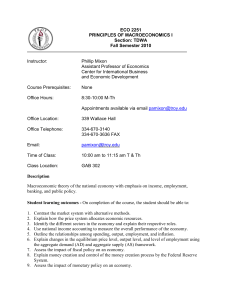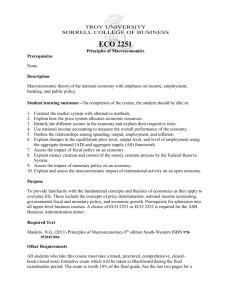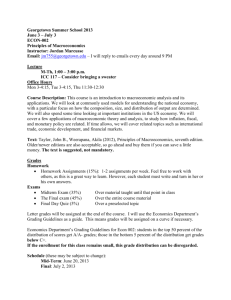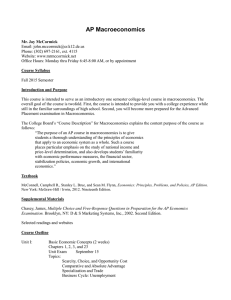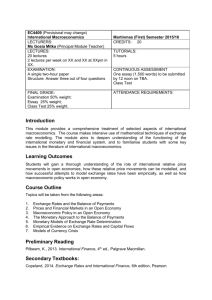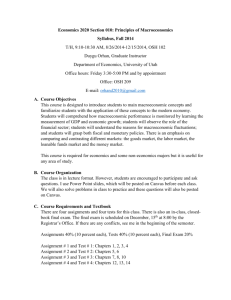ECO 2251 Principles of Macroeconomics
advertisement
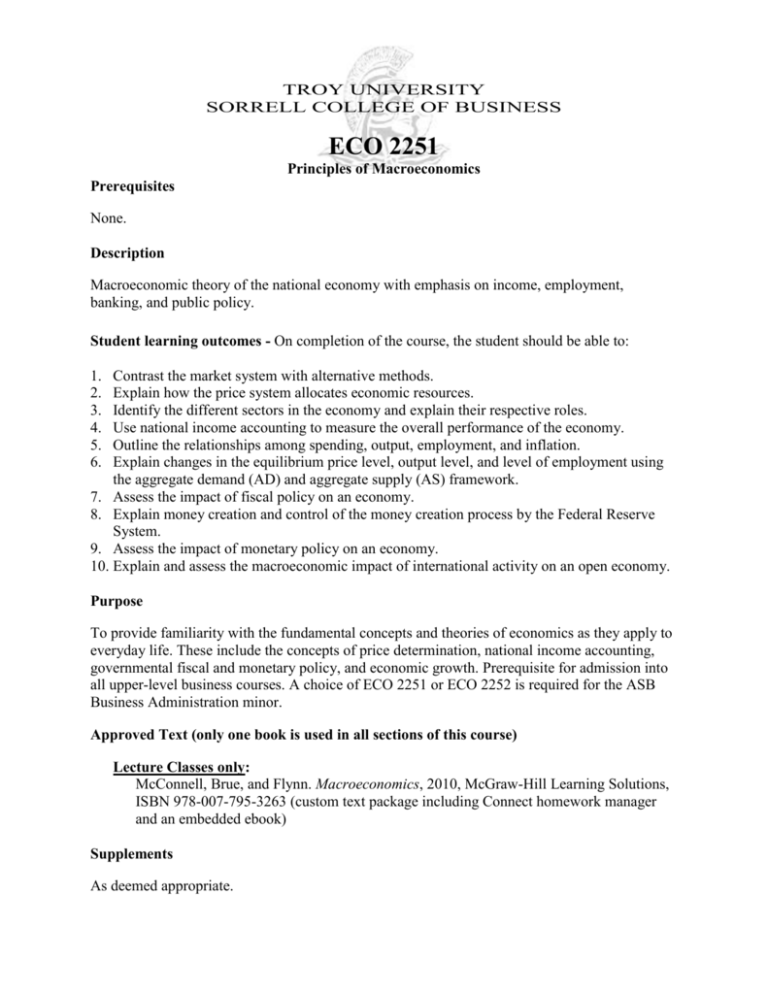
TROY UNIVERSITY SORRELL COLLEGE OF BUSINESS ECO 2251 Principles of Macroeconomics Prerequisites None. Description Macroeconomic theory of the national economy with emphasis on income, employment, banking, and public policy. Student learning outcomes - On completion of the course, the student should be able to: 1. 2. 3. 4. 5. 6. Contrast the market system with alternative methods. Explain how the price system allocates economic resources. Identify the different sectors in the economy and explain their respective roles. Use national income accounting to measure the overall performance of the economy. Outline the relationships among spending, output, employment, and inflation. Explain changes in the equilibrium price level, output level, and level of employment using the aggregate demand (AD) and aggregate supply (AS) framework. 7. Assess the impact of fiscal policy on an economy. 8. Explain money creation and control of the money creation process by the Federal Reserve System. 9. Assess the impact of monetary policy on an economy. 10. Explain and assess the macroeconomic impact of international activity on an open economy. Purpose To provide familiarity with the fundamental concepts and theories of economics as they apply to everyday life. These include the concepts of price determination, national income accounting, governmental fiscal and monetary policy, and economic growth. Prerequisite for admission into all upper-level business courses. A choice of ECO 2251 or ECO 2252 is required for the ASB Business Administration minor. Approved Text (only one book is used in all sections of this course) Lecture Classes only: McConnell, Brue, and Flynn. Macroeconomics, 2010, McGraw-Hill Learning Solutions, ISBN 978-007-795-3263 (custom text package including Connect homework manager and an embedded ebook) Supplements As deemed appropriate. Other Requirements All students who take this course must take a timed, proctored, comprehensive, closedbook/closed notes formative exam which will be taken in Blackboard during the final examination period. The exam is worth 10% of the final grade. See the last two pages for a detailed list of subtopics included. These topics must be covered by all instructors at the minimum in their courses. Topics covered on formative final examination: The test consists of questions selected at random from pools on each of the learning objectives listed on page 1. Areas included are as follows (chapter numbers come from the custom edition): 1. Contrast the market system with alternative methods. (Ch. 1-2) understand the nature of the economizing problem and why it comes about, to include the various economic resources used to satisfy our economic wants. distinguish positive from normative analysis understand the differences between a market and command system, as well as the shortcomings of each know the fundamental questions that the market system answers 2. Explain how the price system allocates economic resources. (Ch. 1, 3) define the concept of the invisible hand know how to calculate both marginal and total opportunity costs using a graph or table as well as how economic growth is shown on a production possibilities curve understand production possibilities analysis, including attainability and efficiency of resource use, tradeoffs, and the law of increasing opportunity cost understand how market equilibrium is determined and the rationing function of prices know the determinants of demand and supply and how changes in non-price determinants shift the curves and change equilibrium price and quantity 3. Identify the different sectors in the economy and explain their respective roles. (Ch. 2, 4) understand the circular flow model identify the major sectors of the economy understand the economic functions of government know the major categories of federal, state, and local expenditures, as well as how these expenditures are financed 4. Use national income accounting to measure the overall performance of the economy. (Ch. 6) define nominal GDP and real GDP, and be able to calculate real GDP using a price index know what is counted in GDP and what is not counted, as well as the shortcomings of this measure calculate GDP or its components using the expenditure or income approaches understand the basic components of GDP 5. Outline the relationships among spending, output, employment, and inflation. (Ch. 5, 7, 8, 11, 16) understand how economic growth is measured and the major causes of growth define a business cycle and be able to identify the stages know how the unemployment rate is measured as well as the types of unemployment and its consequences know how inflation is measured as well as its causes and impact on the economy understand the difference between cost-push and demand -pull inflation, and how government policymakers can correct for each understand the relationship between inflation and unemployment using a Phillips curve approach 6. Explain changes in the equilibrium price level, output level, and level of employment using the aggregate demand (AD) and aggregate supply (AS) framework. (Ch. 9, 11) understand the determinants of consumption and investment spending and how each impacts the level of spending know why the AD curve slopes downward understand the determinants of AD and AS curves, as well as shift and change factors understand how equilibrium is determined in an AD/AS framework and what changes in each curve represent in the macroeconomic sense know what the multiplier effect is and how it impacts aggregate demand 7. Assess the impact of fiscal policy on an economy. (Ch. 12) differentiate between expansionary and contraction policy, as well as when policy is appropriate to use in the business cycle understand how fiscal policy impacts the economy using an AD/AS framework know what is meant by automatic stabilizers and how they impact tax revenues understand the problems associated with implementing fiscal policy, as well as what the crowding-out effect is know the difference between the federal budget deficit and the debt understand the difference between cyclical and structural budget deficits or surpluses understand the major concerns about high levels of government debt 8. Explain money creation and control of the money creation process by the Federal Reserve System. (Ch. 13, 14) understand the functions of money in an economy know the primary components of the money supply, including M1 and M2 understand what influences the value of money know the basic functions the Federal Reserve system provides in the US economy, as well as characteristics such independence given data, calculate the reserves available for lending and how changes impact the money supply understand what fractional reserve banking is and what constitutes assets or liabilities on the balance sheets of commercial banks or the Federal Reserve explain how multiple deposit expansion works, including how to calculate and use the simple money multiplier 9. Assess the impact of monetary policy on an economy. (Ch. 15) know the components of the demand for money understand the three basic tools of monetary policy and how they impact the money supply know what the Federal Funds rate is and how the Federal Reserve influences it understand the difference between expansionary and contraction monetary policy and when each would be used know how monetary policy influences the level of real GDP and the price level in an AD-AS framework understand the problems associated with using monetary policy, such as lags and cyclical asymmetry 10. Explain and assess the macroeconomic impact of international activity on an open economy. (Ch. 17) understand how exchange rates are determined and be able to do simple calculations from one currency to another know the basic components of the balance of payments, including how do basic calculations given data know the difference between fixed and flexible exchange rates Chapters included in the Required Custom Textbook 1) Troy Chapter Number 1 2 3 4 5 6 7 8 9 10 11 12 13 14 15 16 17 Chapter Title Limits, Alternatives, Choices The Market System and the Circular Flow Demand, Supply, and Market Equilibrium The US Economy: Private and Public Sectors An Introduction to Macroeconomics Measuring Domestic Output & National Income Economic Growth Business Cycles, Unemployment, & Inflation Basic Macroeconomic Relationships The Aggregate Expenditures Model (optional, 4) Aggregate Demand and Aggregate Supply Fiscal Policy, Deficits, and Debt Money and Banking Money Creation Interest Rates and Monetary Policy Extending the Analysis of Aggregate Supply The Balance of Payments, Exchange Rates, and Trade Deficits 2) Macroeconomics 18th ed. (non-custom ) Chapter Number 1 2 3 4 6 7 8 9 10 11 12 13 14 15 16 18 21 3) eBook or Economics (18th ed.) Chapter Number 1 2 3 4 23 24 25 26 27 28 29 30 31 32 33 35 38 Notes: 1) TROY’s custom edition does not contain all the chapters included in the "full" text or national macroeconomics split editions. Chapters have been renumbered as listed. 2) If students buy a used, non-custom macroeconomics split, these are the corresponding chapter numbers. These chapter numbers are not for the "brief" edition, but for the normal macroeconomics split (contains more chapters). 3) If students use an ebook (such as what is included in Connect) or buy a used copy of the full economics text (containing both macro and micro), these are the corresponding chapter numbers. 4) This chapter is not tested on in the formative exam, so it is optional to cover. Grading There are 100 possible points available in this course. These points will be split into 3 mid-term exams each worth 30 points or a total of 90 points and a comprehensive final exam worth 10 points. I will use the standard 10 point grading scale. Please note this scale will not be altered for any reason.

